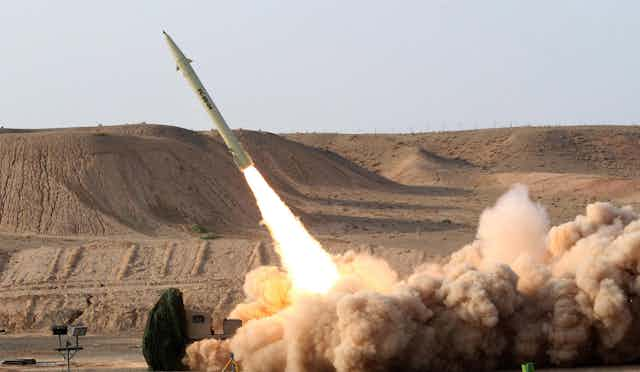It has been reported that Iran is preparing to transfer short-range ballistic missiles to Russia for use against targets in Ukraine, allegedly as part of a shipment of 1,000 additional weapons of unspecified type. Iran has allegedly already transferred a number of unmanned aerial vehicles (UAVs) to Russia. Many of these drones have been used in Ukraine, although the Islamic Republic has denied involvement.
I have researched Russia’s military industrial complex under sanctions, as well as Iran’s procurement for its own weapons programmes. This has led me to believe that the transfer of these systems, while allowing Russia to continue to inflict horrendous death and destruction against civilian populations and infrastructure in Ukraine, is unlikely to change the overall strategic balance.
Iranian “kamikaze” drones have been involved in attacks on Kyiv and other targets in recent weeks. Members of the Islamic Revolutionary Guard Corps – a Iranian paramilitary unit – have allegedly been sent to Crimea to assist in operating the systems.
Missiles for Moscow?
The Fateh-110 and Zolfaghar ballistic missiles allegedly being prepared for transfer by Iran to Russia are based on different technology to these UAVs already transferred. The range of the missile systems is shorter than those of the UAVs (300km-700km as opposed to alleged 2,500km range of the Shahed-136 UAV, for example).
But ballistic missiles travel at much higher speeds (often measured in km/second rather than km/hour). This makes defending against these systems and the explosive warheads they carry much more challenging – if not impossible – for Ukrainian forces with current capabilities.
Ukraine has reported it has been able to intercept more than 70% of the propeller-driven Iranian UAVs using a mixture of fighter aircraft, air defence systems and even small arms fire. They would not be able to achieve anything like this success rate against ballistic missiles.
The Fateh-110 and Zolfaghar have similar characteristics as those ballistic missiles already fired by Russia during the conflict to date, namely speed and ability to penetrate air defences.
Why seek Iranian support?
This is not the first time that Iran has transferred its missile technology to overseas customers. Since the 1980s the country has had a bilateral relationship with North Korea where technology has at some points flowed in both directions. It has also provided missiles to Hezbollah in Lebanon and more recently to Houthi rebels in Yemen.
But, despite a long history of political and commercial relations with Tehran, Russia is a new market for Iranian missile technology, and an unusual one given Russia’s vast military industrial complex. But the conflict in Ukraine has continually challenged orthodox views of Russia’s perceived capabilities on the battlefield and in its weapons factories.
In seeking Iran’s support, Russia is likely trying to replenish stocks of missiles expended so far during the conflict, with patterns of weapons use suggesting that its arsenal may be depleted in certain areas. It is also trying to offset some of the challenges faced by the Russian defence industrial complex’s efforts to replenish stocks.

Russia’s weapons manufacturers are stretched to the limit by efforts to restock. The country also faces a wide-ranging arms embargo, which for many western states including the EU dates back to the 2014 seizure of Crimea or before, and restrictions on the acquisition of dual-use technologies tightened in February this year.
Russia has likely used illicit procurement networks – many run by Russian and before that Soviet intelligence – and long-practised tactics such as the use of front companies in third countries to try to get around these restrictions. Western intelligence efforts have long tried to track these networks, occasionally obtaining insights into Russian technologies.
The insights provided by wreckage recovered from Ukraine, however, have been unprecedented. Remains of Russian weapons systems recovered from Ukrainian battlefields – missiles, drones, electronic warfare and other land systems – have been found to be rich in western technology illicitly procured from the international market place.
The same is true for Iranian drones, 300 of which have been shot down in the past fortnight according to Ukrainian president Volodymyr Zelensky.
Besides Russia’s need for weaponry, there are clearly political and diplomatic considerations for Vladimir Putin. Russia is highly isolated, and international political support for Moscow is coming from a shrinking circle of states. So Russia has turned to Iran and a small number of other countries on the periphery of the international system such as North Korea, which is allegedly transferring artillery ammunition to replenish Russian stocks.
While providing political benefits for Russia and reducing its isolation, the deal also brings economic benefits for Iran, which has faced significant international sanctions over the past decades, due to its nuclear programme. For both countries, then, bilateral trade will highly beneficial. Russia is thought likely to veto any further UN sanctions against Iran.
What can be done?
The proliferation of Iranian ballistic missiles into the European theatre is not good news. Use of weapons on the battlefield can provide vendors a useful opportunity to test systems in new operational contexts, and could potentially act as a marketing opportunity to showcase these systems to other potential customers.
There are no easy options for countering these arms transfers. This will be especially true if the missiles can be delivered by air like the UAVs supplied by Iran appear to have been. Direct flights provide no opportunities for interdiction.
The US and partners have imposed asset freezes, restrictions on travel and other business activities against Iranian drone manufacturers and operators – and may take new and further measures. They have stated they will continue efforts to disrupt Iran’s networks.
We may also see the US return to extraterritorial tools used in the past to get at parts of these transnational networks based overseas. This includes sting operations, civil asset seizures and information operations. Essentially, the “cat and mouse” game between the US and its allies and Russia and its suppliers will continue – but with new targets and heightened energy.

